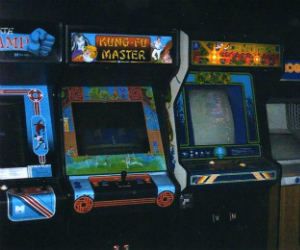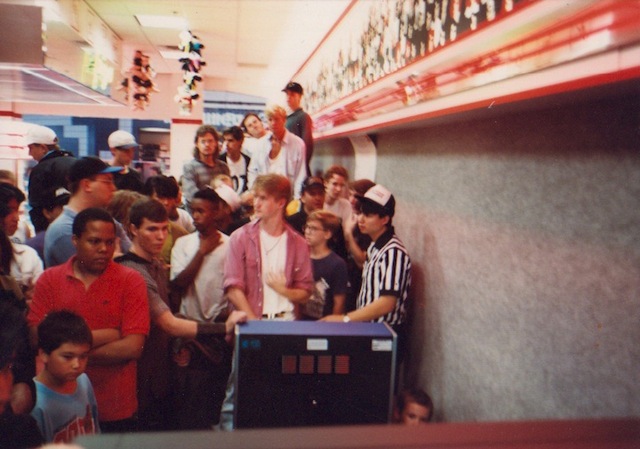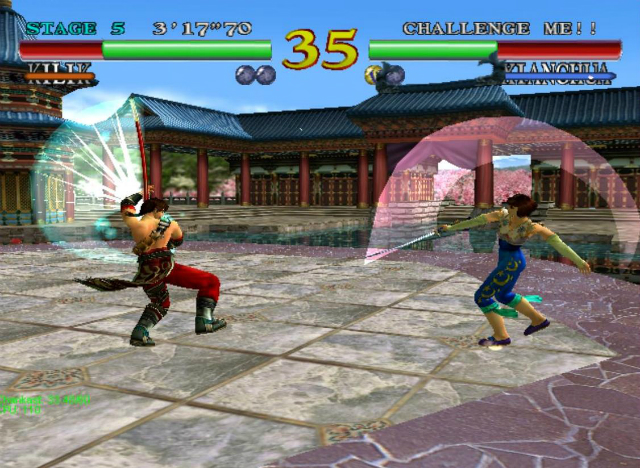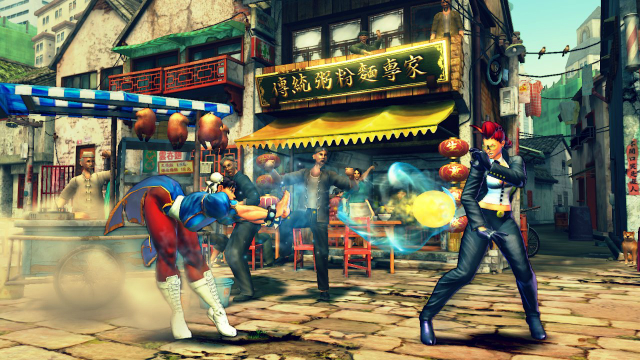Arcade Impact – A Lament to Years Gone By…
 Picture the scene, it’s 1992 and I’m fighting through a crowd of people I don’t know to get a good spot to see what was happening. Washington, our local Street Fighter II champion, has been challenged by another player from a different neighbourhood. They both pop in their quarters and pick their fighters. Washington picks his staple, Ryu, while the challenger picks Blanka. The trademark “Round 1, Fight!” bellows from the arcade cabinet and they’re both off.
Picture the scene, it’s 1992 and I’m fighting through a crowd of people I don’t know to get a good spot to see what was happening. Washington, our local Street Fighter II champion, has been challenged by another player from a different neighbourhood. They both pop in their quarters and pick their fighters. Washington picks his staple, Ryu, while the challenger picks Blanka. The trademark “Round 1, Fight!” bellows from the arcade cabinet and they’re both off.
The furious joystick movements and button presses are accented by the oohs, aahs, and other gasps from the watching crowd. Washington comes out victorious in round one and loud cheers ring out as if he just scored a buzzer shot in a heated basketball contest. The noise dies down as “Round 2, Fight!” bellows and once again everyone is focused. This round is a bit closer, but the challenger is no match for Washington. He wins and the hometown crowd is pleased. High fives, even hugs are exchanged. People are discussing the strategy behind the contest as if it were a tried and true boxing match.
Immediately afterwards, Washington gives up his game because the computer AI is no match. People rush to the game and begin to play each other, each trying to emulate what they just saw. None of us here are friends but we all share a similar joy. The community of arcade gaming.

Unfortunately this is not a situation today’s gamers will be a part of. Sadly the arcade cabinet and the culture behind it are mere shadow of what it once was. Sometimes people laugh when I say it was a culture, but that’s exactly what it was. People had rituals they would follow. Every Saturday morning, a group of friends and I would get together and go to our local supermarket. We each would stand behind a pay aisle and pack bags for tips. Luckily most people tipped in quarters. After about 2 hours we would pool our money and head to the local arcade called Playland.
Conveniently there were four of us so we horded Teenage Mutant Ninja Turtles until we beat it. Next week it was Captain America and the Avengers, then it was The Simpsons and X-Men. The amazing thing about these experiences wasn’t the games but the camaraderie we shared. It was about the commute to the shop where we talked about what characters we’d pick, and who gets the energy capsules if we were all low on energy. Anyone who has played any of these four player ventures will know that communication will get you farther on less cash and ultimately avoid arguments. Good conversation indeed.
I thoroughly miss these times, as sadly the arcade cabinets have faded due to the advancements made in home gaming. There was a point where arcade games were far superior in gameplay and graphics, except for the Neo Geo, whose arcade games and home games ran on the same hardware. Even so, I knew of no one who could afford the Neo Geo as it was priced at around $600 for the system and up to $200 for a game cartridge.

Otherwise you had games like Final Fight and Double Dragon which, at the time, were incredible. Sure they had their home counterparts, but there was no way anything on the SNES was matching the arcade. Not even the 16 bit translation of the renowned Street Fighter series was close to the arcade experience. Even though, in retrospect, Capcom did an excellent job in translating the series with the technology they had.
For a while there was really no big threat, even with the introduction of the Sony PlayStation in late 94/95. The PlaySation was a huge step over the 16 bit era as it seemed to be able to translate a better arcade experience. I have to admit the emulation of the Street Fighter series was spot on but there was still a thriving arcade going community. People wanted to enjoy the social areas. There were arcades with food courts, birthday parties, and even group deals and children discounts. My older brother would take me and a group of friends to a popular restaurant in New Jersey by the name of Nathan’s. It had a huge arcade with over 70 arcade units. Between eating and playing we were there easily about 5 hrs, competing for high scores, flexing fighting game muscles, and just having a good time. We would even return home and game even more, but nothing beat the event of a true arcade trip.

As home systems began to become more sophisticated, something unheard of began to happen. The focus of the industry marketing strategy changed. No longer were they trying to emulate the arcade experience, they were trying to create the home experience by outdoing the arcades. The first of such I can remember is Soul Calibur for the SEGA Dreamcast. I saw the advertisements of SEGA boasting it looked and played better than the arcade machine. I paid no attention as I thought there was no way this was possible. I was in college at the time and it’s the day of reckoning, 9/9/99, a friend of mine has pre-ordered a Dreamcast at Walmart and woke up very early to go pick it up. He also happened to purchase two games, NFL 2K and Soul Calibur. That night I travel to his dorm ready to talk trash about how he fell for the advertising scheme. I enter his room and there are about 12 people inside. It was like fighting my way through the crowded arcades back in the peak of the Street Fighter era. Only, when I reached to where I could get a look at this game…I was speechless. Not only did it look better than the arcades, its animation was better, the sound was even better…everything was better! I could not believe it. I had mixed feelings as I knew this was the beginning of the end for my beloved arcades. I couldn’t help but buy in. I too purchased a Dreamcast in the months to come, using a credit card I’m still paying off today. On a another note, the Dreamcast had excellent versions of Marvel Vs. Capcom and Capcom Vs. SNK.
In the next few years, the big guns would bring out their systems, with Microsoft joining the realm, releasing titles better than anything the arcades had to offer. The mentality of “why would you leave your home to pay money to play games worse than the ones you have at home?” reigned supreme. I personally would have loved to have still gone, but this mentality hit the arcades right in their pockets. These machines were no longer paying for themselves in the long run. Eventually it was not cost effective to carry them so they were disappearing everywhere. Gamers were more enthralled with console gaming due to its rapid advancements.
Cut to now, I’m 31 and arcades as I knew them here in New York city are non-existent. Arcade units are no longer in local laundromats or grocery stores. You may find some in movie theaters but they will be more of a novelty such as Fast and the Furious racing or one of the many light gun games. I actually still keep in touch with my gamer friends from my youth thanks to online gaming. Recently all of us got together and created a room in Super Street Fighter IV and we spoke of the old times.

We spoke about how we bonded over our love for games and how our children won’t have the same experiences. We had a few matches and old habits never die, I still pick Ryu and my friends still pick who they would’ve about 20 years ago. After our matches we all decided to give a go at a game of Teenage Mutant Ninja Turtles; the arcade game. We pick our respective characters, of course, and the night will end with a bunch of 30 year old men fighting over who gets the pizza.
It was a fun run, but for me, online gaming will never replace the feeling of being at an arcade with my favourite units. Being able to physically interact with my fellow gamers – my friends – cannot be emulated with a headset. That’s no knock to online gaming. I love it, it keeps the competition and camaraderie going, but there’s nothing like taking a day to unwind at an arcade. Younger folks may not understand. It may not even sound appealing, you know, leaving your home to fight your way through crowds to play the games you love, but trust me, it was absolutely worth it. Arcades produced many stories for me and even local heroes. Its a shame these times seem no more.




